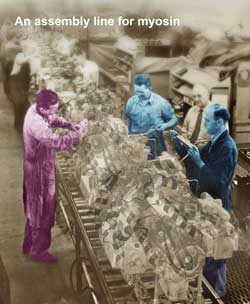How the UNC-45 protein brings muscles into shape

The present work by Gazda et al demonstrates that UNC-45 establishes a multi-chaperone complex that allows the folding of myosin in a defined array along the thick filament. The cartoon illustrates the “patterned folding” principle, of how UNC-45 composes a protein assembly line that places the chaperone mechanics Hsp70 and Hsp90 (highlighted) at regularly spaced positions to work on the series of motor domains protruding from the myosin filament.<br>Copyright – please specify: With friendly permission from David Greenlees<br>
Researchers of CECAD, the Cluster of Excellence at the University of Cologne, Germany, and the Research Institute of Molecular Pathology (IMP) in Vienna, Austria, provide mechanistic insight how muscle assembly is regulated in development and aging.
Muscle formation and function rely on the correct assembly of myofilaments that are composed of actin and myosin molecules. In a novel study the researchers now discovered the molecular basis underlying the patterned folding and assembly of myosin filaments.
Muscle development and function rely on the correct assembly of contractile units called the sarcomeres. Its main components, thin (actin) and thick (myosin) filaments are organized in a precisely ordered, quasi-crystalline protein framework that mediates muscle contraction. Although the overall architecture of the sarcomere has been studied in detail, little is known about its complicated assembly process. In particular, the mechanism of myosin incorporation into thick filaments is poorly understood.
The Hoppe lab and others have shown before that the folding of myosin involves the assistance of three molecular chaperones including Hsp70, Hsp90 and a myosin-specific assembly protein called UNC-45. To address the underlying principle of how myosin filaments are formed in muscle cells, Prof. Thorsten Hoppe and his postdoc Wojtek Pokrzywa teamed up with PD Dr. Tim Clausen and his group to perform a detailed structural and physiological analysis of the UNC-45 protein from the soil nematode Caenorhabditis elegans.
The striking findings of this collaboration, published in the scientific journal Cell, revealed that UNC-45 can polymerize into a linear protein chain. As a consequence, multiple binding sites for the myosin substrate as well as for the co-working chaperones Hsp70 and Hsp90 are periodically arranged along the UNC-45 chain. Indeed, this multi-chaperone complex that works on a series of myosin motor domains mimics an industrial assembly line (Fig.1). This mechanism decisively alters the current view of how muscle filaments are formed during development and kept in shape upon aging:
(1) The UNC-45 chaperone functions beyond simple nascent protein folding. It represents a novel type of filament assembly factor that provides the molecular scaffold for Hsp70 and Hsp90 chaperones to work at regularly spaced positions on captured client proteins. It will be interesting to see whether this “patterned folding” mechanism is critical for the assembly of other protein filaments.
(2) The Hoppe lab showed before that aberrant UNC-45 function is associated with severe muscle defects resulting in skeletal and cardiac myopathies. Therefore, the discovered mechanism may help to develop strategies against diseases connected with myosin assembly defects.
Publication:
Gazda et al., The Myosin Chaperone UNC-45 Is Organized in Tandem Modules to Support Myofilament Formation in C. elegans, Cell (2013), http://dx.doi.org/10.1016/j.cell.2012.12.025
For further Information, please contact:
Prof. Thorsten Hoppe
CECAD Cluster of Excellence at the Universität of Cologne
Zülpicher Straße 47a . 50674 Köln
+ 49 (0) 221-470-1503 . e-mail: thorsten.hoppe@uni-koeln.de
CECAD PR & Marketing, Astrid Bergmeister
+ 49 (0) 221-470-5287 . e-mail: astrid.bergmeister@uk-koeln.de
Media Contact
All latest news from the category: Life Sciences and Chemistry
Articles and reports from the Life Sciences and chemistry area deal with applied and basic research into modern biology, chemistry and human medicine.
Valuable information can be found on a range of life sciences fields including bacteriology, biochemistry, bionics, bioinformatics, biophysics, biotechnology, genetics, geobotany, human biology, marine biology, microbiology, molecular biology, cellular biology, zoology, bioinorganic chemistry, microchemistry and environmental chemistry.
Newest articles

Properties of new materials for microchips
… can now be measured well. Reseachers of Delft University of Technology demonstrated measuring performance properties of ultrathin silicon membranes. Making ever smaller and more powerful chips requires new ultrathin…

Floating solar’s potential
… to support sustainable development by addressing climate, water, and energy goals holistically. A new study published this week in Nature Energy raises the potential for floating solar photovoltaics (FPV)…

Skyrmions move at record speeds
… a step towards the computing of the future. An international research team led by scientists from the CNRS1 has discovered that the magnetic nanobubbles2 known as skyrmions can be…





















